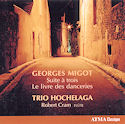 Migot - Suite à trois; Le livre des danceries
Migot - Suite à trois; Le livre des danceries
Robert Cram; Trio Hochelaga
ATMA ACD2 2543
Intense in his spirituality, drawing on the rich diversity of French music, and inspired by the Touraine landscape, Georges Migot (1891-1976) could not fail to achieve fame as president of La Spirale, the Parisian society dedicated to offering performances of new French works.
Migot’s Trio of 1935 commences with the Modéré, an intense - and clashing and disjointed - movement. It is almost a duel between piano and violin. It is followed by an Allègre. Both movements make great demands on the skills of cellist Paul Marleyn and violinist Anne Robert; their skills ensure that this recording matches up to the description of the Trio as one of the most arresting pieces of French chamber music.
Third movement is the Danse, where Stéphane Lemelin’s piano-playing comes into its own, as intense as the string parts, but more disciplined as the piano is denied the liberty that the latter enjoy as they invoke France’s varied heritage. Last is the Final: no instrument dominates and Migot allows each to test its player’s skill. This is an intense suite of chamber music, a challenge to preconceived ideas of classical ensembles.
In very different spirit is the Livre des Danceries where flautist Robert Cram introduces a sprightly quality which is eventually taken up by the piano part in the second - Gai - movement. At last, the CD’s pianist can relax! Next is Réligieux, longest of the four movements, drawing on melodic religious sources. And then Conclusion, from the earliest bars a celebration of the other movements and an exciting way to round off Trio Hochelaga’s vigorous interpretations.



